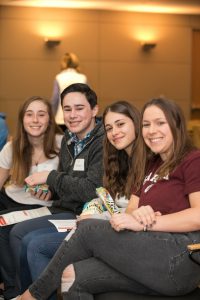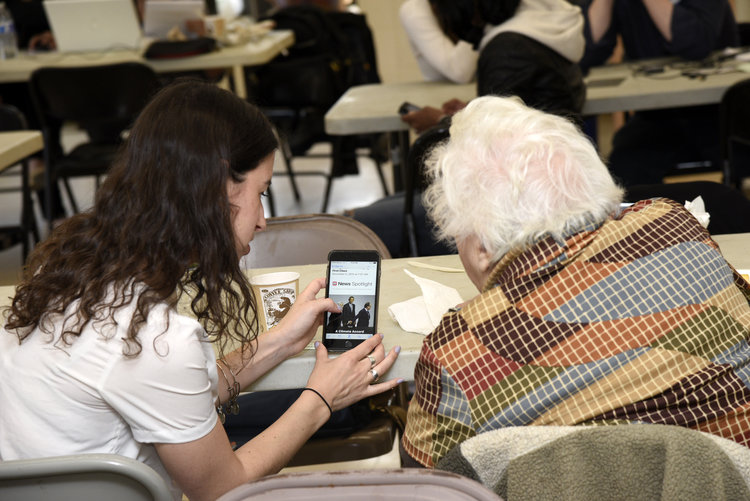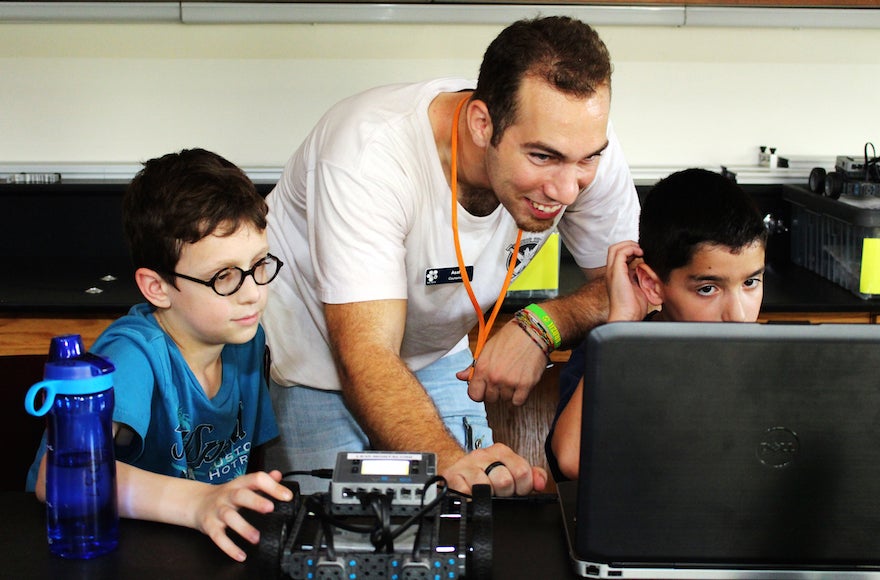The teen years have always been a challenge. Figuring out who you are; navigating complex social systems; being pressed to succeed academically; a body that changes from day to day—almost no adult would willingly return to adolescence.
In our intense modern world, with a 24/7 fishbowl of social media and a heated and polarized public debate, it is no wonder that levels of anxiety and depression are increasing, even for the most successful teen children.
Fortunately, we continue to learn more every day about how to best help teens. Years of research have identified the factors that support teens to grow and thrive: adult mentors; supportive peer groups; the safety to explore difficult and personal issues with depth and honesty; and a community with a robust values system.
Judaism and Jewish community can–and does–offer this to teens.
Our ancient Jewish values of treating each other as if we are all made b’tzelem Elohim, in the divine image, of caring for the poor and those who are orphaned, and of working for social justice, have special resonance today.
As a field, we now deeply understand the power of helping Jewish teens make meaning of these Jewish values and connecting the values to their everyday lives and interests. Yet, of course, this meaning making does not simply happen. A recent evaluation conducted by Rosov Consulting and commissioned and shared by the Jewish Teen Education and Engagement Funder Collaborative–comprised of national and local funders learning together and catalyzing teen initiatives in ten communities–showed, among other key takeaways, that meeting teens where they are, literally and figuratively, is an integral component to offering Jewish experiences that add value to their lives.
Three of the communities within the Collaborative–Boston, Denver, and Los Angeles–work with Moving Traditions to create these types of experiences that reflect our understanding of teens and their desires today. By fostering positive peer-to-peer relationships in small groups facilitated by trained adult mentors, Moving Traditions’ signature programs, Rosh Hodesh for girls and Shevet Achim for boys, create experiences that have inspired more than 19,000 Jewish teens to find meaning and connection in Jewish life. Moving Traditions also has certified nearly 1,400 educators to mentor the teens in Rosh Hodesh and Shevet Achim groups and it has provided professional development to thousands more Jewish educators who serve teens in a variety of settings.
We know the effectiveness of this work thanks to an independent evaluation. Moving Traditions found that when its Jewish learning promotes self-discovery, challenges conventional views of gender, and celebrates a diversity of voices, teens grow into adulthood with confidence and compassion. Now, with a new investment from the Jim Joseph Foundation (nearly $1 million over four years), Moving Traditions will build its national organization, deepening the quality of its programming and growing its reach.
Emphasizing healthy living and well-being benefits thousands of Jewish teens, as does helping them to find Jewish friends, derive meaning from Jewish wisdom, and develop an ongoing connection to Jewish community. Just a few results from the evaluation bear this out:
- 91% of group leaders reported that the program helped girls gain the emotional skills to deal with life’s changes
- 94% of past participants said that Rosh Hodesh increased their sense of connection with Jewish girls and women.
- 71% of past Rosh Hodesh participants have continued to be involved in Jewish or women’s activities after the program ended.
- 81% of institutional partners running Rosh Hodesh believe that the program helped them retain girls post bat mitzvah.
Anecdotal evidence (input from participants, partners, and group leaders through annual evaluations and direct feedback) suggests similar outcomes for boys in the Shevet Achim program. An independent evaluation of that program is planned for the future.
Moving Traditions’ work within the three communities of the Funder community allowed it to prove the model. The Teen Funder Collaborative offered a blank canvas of sorts to experiment with collaborations, program structures, and other variables. Local funding partners within the Funder Collaborative, which have supported Moving Traditions, unabashedly said that investing in the national office is a promising opportunity to amplify existing work. The independent evaluation affirmed this sentiment, and both were key factors in the Jim Joseph Foundation’s decision to make the new investment.
Moreover, Moving Traditions’ 2015-2020 strategic plan and recently completed business plan provide a roadmap for the organization to move forward, with two comprehensive strategies outlined to widen its scale and deepen its impact:
- Graduated pathway to teen engagement, incorporating new programming—the b’nai mitzvah program and an online group for transgender teens—and refining its signature programs, Rosh Hodesh and Shevet Achim.
- Pyramid of training for adults who mentor teens, refining Moving Traditions’ pre-service training and adding advanced training for Rosh Hodesh and Shevet Achim group leaders and including training for other Jewish educators, including camping staff.
With this plan, the organization also is poised for sustainability and capacity, positioning it to make significant contributions to the lives of Jewish teens and the broader field of Jewish teen engagement.
This is a very timely development. When teens drop out of Jewish life post-b’nai mitzvah, as so many do, it is not merely a loss for the Jewish community–it is a loss for teens as well. The two years after b’nai mitzvah happen to be the years in which many teens begin to take risks in terms of alcohol, drugs, and sexual activity; encounter serious academic pressure; and experience difficulty in their relationships with their parents.
Moving Traditions offers a compelling framework to counter these trends. What started small within a few communities in the Funder Collaborative now has the opportunity for national impact. It is a strategic investment born from years of learning designed to engage an important audience with thoughtful, ongoing Jewish learning experiences.
Deborah Meyer is CEO of Moving Traditions. Jeff Tiell is a Program Officer of the Jim Joseph Foundation.






 The
The  In addition to information about each community initiative within the Collaborative, extensive research on teens, and reflections from practitioners on the ground, the website shares two new items: the
In addition to information about each community initiative within the Collaborative, extensive research on teens, and reflections from practitioners on the ground, the website shares two new items: the  The communities in the Funder Collaborative are Atlanta, Baltimore, Boston, Chicago, Cincinnati, Denver, Los Angeles, New York, San Diego, and San Francisco. Teen initiatives that have been launched by Funder Collaborative communities include a range of Jewish experiences—from volunteer service to professional internships to surfing and more. Nearly all communities attribute early programmatic successes to their participation in the collaborative and its steadfast commitment to knowledge-sharing. The evolution of the collaborative itself is central to creating an environment that fosters risk-taking, experimentation and ongoing reflection.
The communities in the Funder Collaborative are Atlanta, Baltimore, Boston, Chicago, Cincinnati, Denver, Los Angeles, New York, San Diego, and San Francisco. Teen initiatives that have been launched by Funder Collaborative communities include a range of Jewish experiences—from volunteer service to professional internships to surfing and more. Nearly all communities attribute early programmatic successes to their participation in the collaborative and its steadfast commitment to knowledge-sharing. The evolution of the collaborative itself is central to creating an environment that fosters risk-taking, experimentation and ongoing reflection. By day, Liora Brosbe is the family engagement officer for the Jewish Federation of the East Bay in Berkeley, Calif., where she reaches out to the community with a menu of opportunities for “connecting to Jewish life and each other.”
By day, Liora Brosbe is the family engagement officer for the Jewish Federation of the East Bay in Berkeley, Calif., where she reaches out to the community with a menu of opportunities for “connecting to Jewish life and each other.”

